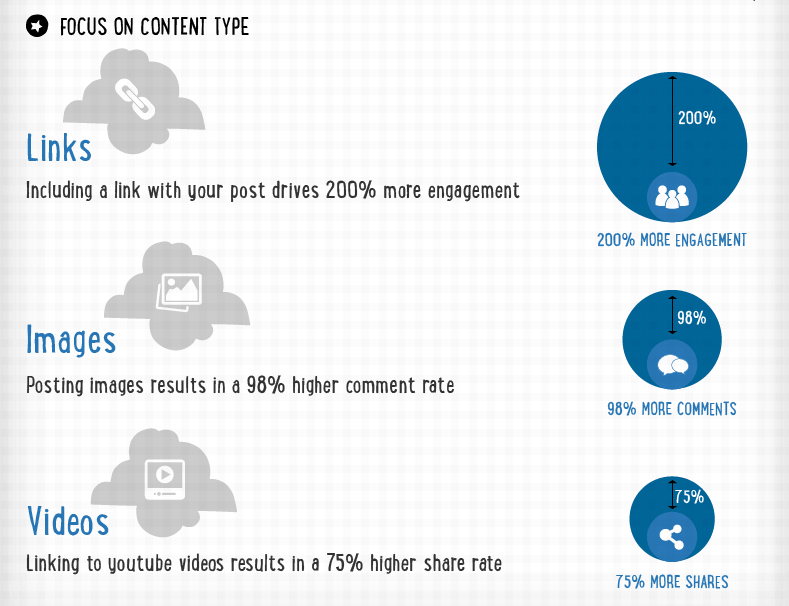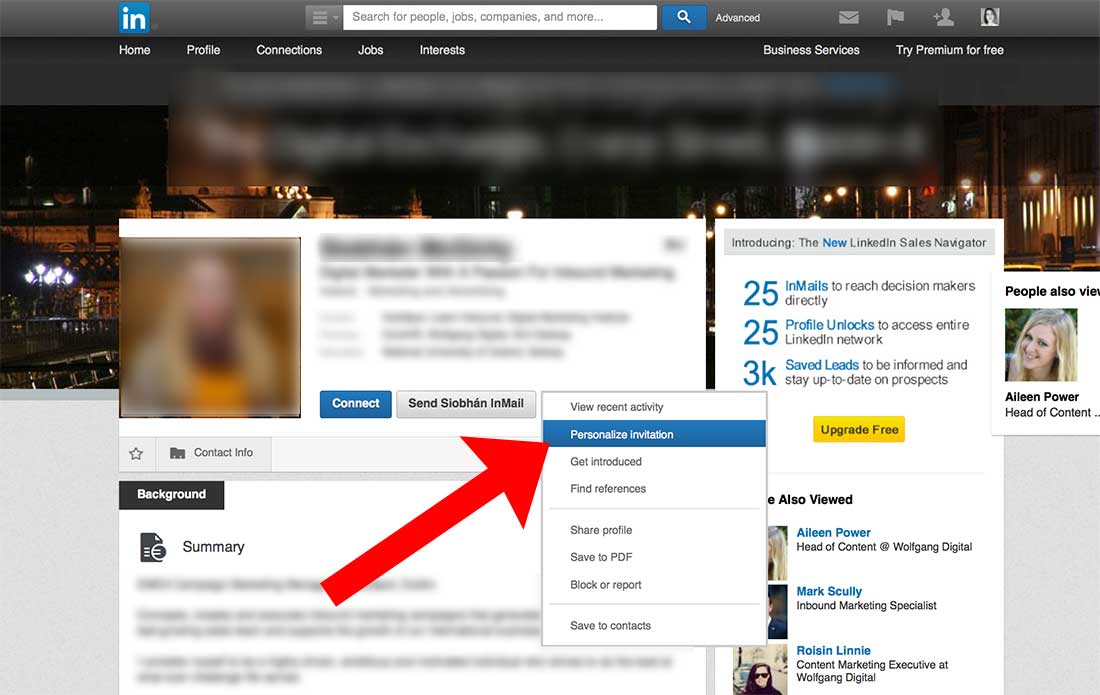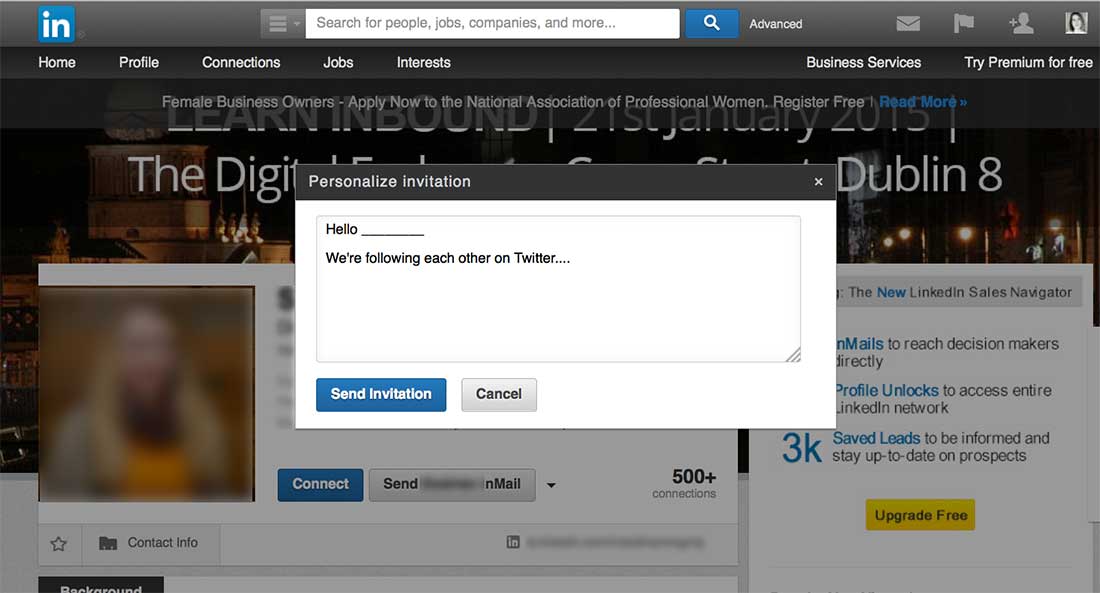LinkedIn may not be as big as Facebook, but if you’re in B2B, it’s essential. If you’re a content marketer, especially if you’re a B2B content marketer, LinkedIn has to be part of your content promotion strategy.
Several sources (like eMarketer) have documented that while they may get the bulk of their social shares from Facebook and Twitter, when it comes to actual traffic to their site, LinkedIn is #1. Here’s some research from Investis that shows this:

LinkedIn is attractive, but can play hard to get
While LinkedIn seems like the perfect place to promote content, sometimes it gives content marketers a chilly reception. Maybe you’ve run into this. Maybe you announced a new post on a group and got your discussion moved over into the promotions category. Or even worse… maybe your new discussion got marked as spam.
That can sting, but there’s no reason to give up. You just need to know some of the etiquette rules on LinkedIn. And that some tactics work far better than others. To help you out, we’ve put together this list of LinkedIn content promotion tactics so you can start getting more attention for your content and your business.
Editor’s note:
In marketing, persistency pays off. Whether you’re running email marketing campaigns or promoting your business on social media platforms like LinkedIn – sometimes you need to resend your message to reach your goals. When you do that, make sure not to overwhelm your audience by paying close attention to your engagement metrics.
How to promote content on LinkedIn in 6 ways:
- Post daily, and post right.
- Build your following.
- Use Groups.
- Use Pulse, LinkedIn’s Publishing Platform.
- Add content to your publications list.
- Buy some Sponsored Updates advertising.
1) Post daily, and post right.
If you can do only one thing to promote your content on LinkedIn, publish a new status update every day. Just once a day is good, and you can even skip weekends. Posting more often than that is considered a bit too much according to most studies. Don’t worry – you don’t have to manually create an update every day. Use a tool like Buffer or Hootsuite to queue up a week or more worth of updates at one time.
Here are some other basics for crafting the ideal LinkedIn status update:
- Link titles should be less than 70 characters. Any longer and they’ll get cut off.
- Link descriptions should be 250 characters or less. Sharing a link from a page on your site? The meta description will be used as the default link description.
- Link early and often.
You’ll get double the engagement if you include links in your updates. That’s according to According to QuickSprout’s infographic, How to Increase Your LinkedIn Engagement by 386% excerpted below:

- Include images and videos. You’ll get 98% more comments with an image, and 75% more shares with a video.
- Share your SlideShares! LinkedIn bought SlideShare two years ago. Now the two go together like PB&J.
- Post in the morning. Even as early in the morning as 6 or 7am your time.
2) Build your following.
Let’s say you’ve just queued up a bunch of awesome LinkedIn status updates, all built according to the best practices above. That’s great. But who’s going to see them? Now you need some connections. A lot of connections.
But you don’t want just any connections. You want people in your industry. Why? Because if someone isn’t in your industry, how likely are they to read, share and engage with your content? So go after the people who are your ideal readers – your ideal clients, or customers, or peers.
There are whole books written about building your connections on LinkedIn, but I’ll share a tip with you. With this technique, I get about 90% of my LinkedIn invites accepted, often from people who are rock stars in my industry. Just keep in mind the LinkedIn connection limit to avoid hitting the cap on the number of connections you can have.
How do I do it? I use Twitter. You see, people follow other people on Twitter pretty freely. Many of us have at least a couple hundred followers on Twitter, if not several thousand. You can also build your Twitter following by just going out and following about 30-50 people per day. Again, choose people who are your ideal clients, customers, or peers.
Some of those people will follow you back. About a week or more after they’ve followed you back, go find them on LinkedIn. Send an invite that says something like this:
Hello [Their First and Last Name].
We’re following each other on Twitter. [Add a sentence if you’re also in any groups together, and name those groups].
I thought I’d reach out and see if we could connect here, too.
Regards,
Your Name
This is, of course, a custom invite. Just so you don’t make the same mistake I’ve made a few times, DO NOT just click the blue invite button. Clicking that button will send the default invite. Some people consider those default invites downright rude. Whether they’re rude or not, canned invites usually get ignored.
Instead of clicking that deceptive blue invite button, click the little black arrow to the right of the invite button. Then write your custom invite in the pop-up window that appears.
Like this:

And then this:

3) Use Groups.
LinkedIn Groups are a content promotion candystore – if you know how to use them. But a lot of people either don’t know how to promote their content politely, or they don’t care too much if they irritate other group members. Some LinkedIn users get so frustrated with all the content promotion “spam” that they leave the group. Other people stay, despite the “plague” of content promotion.
Unfortunately, some of the “content promotion” I’ve seen on LinkedIn could legitimately be called spam. And there is enough of it on some groups to warrant the term “plague”. I’m talking about content with typographical errors in the headline, or content that’s all opinion with no research to back it up. Or content that looks terrible. Or rehashed content on a subject that’s been written about hundreds of times.
But you wouldn’t promote content like that on LinkedIn, right? So I don’t need to say anything about content quality. And while I cannot give you a list of groups that it’s okay to promote content to, I can give you some guidelines:
- Read the group’s rules about promoting content before you do anything.
- If you do promote content, promote other people’s content as much as you promote your own.
- Don’t promote content all the time. Once a week should be the maximum. Once a month is more polite.
- Be careful about using blog syndication software like Buffer or Hootsuite to automatically post to a group.
- Avoid using the words “I”, “me” or “my”. Many LinkedIn groups filter for those words. Any post that includes those words can get automatically moved over into the dreaded “Promotions” section, where it’s not likely to get read.
- Leverage social listening to monitor group discussions and identify opportunities where your content can provide value, helping you engage more effectively and authentically.
The best way to promote content is to find a discussion that is directly related to your content. Add a thoughtful and helpful comment that includes a link to your content. Don’t sell your link – include it as if it was a reference. This will take 5-6 times more work than just autoposting. But it’s the most ethical and effective way to promote content. Also make sure that you only add one of these embedded link comments to every third or fourth comment you make.
4) Use Pulse, LinkedIn’s Publishing Platform
If you haven’t tried publishing a post on LinkedIn yet, it’s time. Pulse posts can get massive exposure. They can deliver more traffic and attention than if you published the same piece on your site. Unless, of course, you’ve got a super-popular blog.
Noah Kagan of OKDork and Paul Shapiro of Search Wilderness did a detailed study of 3,000 Linkedin articles. Here’s just a few trends they found:
- Use eight images. Yes, exactly eight.
- Don’t add videos or multimedia assets.

- Use five, seven or nine headings

- Write long content. Really long content.

A word about republishing content on LinkedIn – some people republish the blogs posts from their own blog onto LinkedIn’s publishing platform. Some publish their LinkedIn posts exactly as those posts appeared on their blog. Other writers change the headlines a bit. Still others do light edits. If you really want to do this, I recommend changing the headline and doing some light edits. Also, don’t repost too many of your blog posts – write at least some unique new content for LinkedIn.
Many other marketers have a different opinion about whether it’s okay or not okay to republish posts. I see some extremely competent bloggers republishing posts with no changes at all. If they’re doing it, it may be fine. But I’m still wary about it.
5) Add content to your publications list.
LinkedIn actually gives us a whole section in our profiles for content promotion. Every headline of a publication can be hyperlinked, so you can even include a call to action to prompt people to click through.
This is a great way to add deep links to your site, or to promote content from all over the web. Add a few images or a video to make your publications look even more interesting.
6) Buy some Sponsored Updates advertising.
If all else fails, you can spend some advertising dollars and just pay to promote your content. If you’re a very small company, that may not be so attractive. But if you’ve got a huge new research study that you really want to get some attention for, paid promotion can work. Expect to pay at least $2 per click on LinkedIn, and often $5 or more per click. It’s not cheap.
Those are the most commonly used ways of promoting content on LinkedIn. Do you know any tricks you might share with us?
Have you tried any promotion tactics on LinkedIn that failed? Let us know in the comments.